tyre pressure FIAT BARCHETTA 2003 1.G Owners Manual
[x] Cancel search | Manufacturer: FIAT, Model Year: 2003, Model line: BARCHETTA, Model: FIAT BARCHETTA 2003 1.GPages: 170, PDF Size: 3.55 MB
Page 76 of 170

75
– Remember that fog also means the
tarmac is wet and therefore manoeu-
vres of all kinds are more difficult and
stopping distances are longer.
– Keep a good distance from the cars
in front of you.
– As far as possible, avoid spurts of
speed or sudden deceleration.
– Do not overtake other vehicles if
you can help it.
– If you are forced to stop your car
(breakdown, limited visibility etc.) try
to stop off the road. Then turn on the
hazard lights and, if possible, the
dipped headlights. Rhythmically sound
the horn if you realise another car is
coming.
DRIVING
IN THE MOUNTAINS
– When driving downhill, use the en-
gine brake by engaging a low gear so
as not to overheat the brakes.
– Under no circumstances should
you drive downhill with the engine off
or with the car in neutral, let alone
with the ignition key out.– Drive at a moderate speed without
cutting corners.
– Remember that overtaking while
going uphill is slower and therefore re-
quires more free road. If you are be-
ing overtaken while driving uphill,
make it easier for the other vehicle
to pass.
DRIVING ON SNOW OR ICE
Here are some tips for driving in
these conditions:
– Keep your speed down.
– Use chains if the roads are covered
in snow (refer to the “Snow chains”
paragraph in this section).
– Mainly use the engine brake and
under all circumstances avoid braking
sharply.
– When braking in a car not fitted
with ABS, avoid the wheels locking by
varying the pressure you exert on the
brake pedal.
– Do not accelerate suddenly and
avoid swerving.– In the winter, even apparently dry
roads may have icy patches. Be care-
ful therefore when driving over
stretches that do not get much expo-
sure to the sun or that are lined by
trees and rocks where ice might not
have melted.
– Keep a good distance from the ve-
hicles in front.
– Do not remain for long periods in
deep snow with the engine running as
the snow could force the exhaust gas-
es into the passenger compartment.
DRIVING WITH ABS
ABS is a braking system that essen-
tially offers two advantages:
1)It prevents wheel lock-up and
consequent skidding in emergency
stops, particularly when the road does
not offer much grip.
2)It makes it possible to brake and
steer at the same time so you can
avoid unexpected obstacles and direct
the car where you want while braking.
The extent to which this can be done
will depend on the physical limits of
the tyre's sideways grip.
Page 77 of 170

76
Here are some suggestions which
may help you to keep the running
costs of your vehicle down and low-
er the amount of toxic emissions re-
leased into the atmosphere.
GENERAL
CONSIDERATIONS
Car maintenance
The overall state of the car is an im-
portant factor which has a marked in-
fluence over fuel consumption and dri-
ving comfort and on the life span of
your car. For this reason care should
be taken to maintain your car by car-
rying out the necessary checks and
regulations in accordance with the
specifications given in the Scheduled
Maintenance Programme (see sec-
tions... spark plugs, idle, air filter, tim-
ing).
CONTAINING RUNNING COSTS
AND POLLUTION
Tyres
Tyres should be checked at least
every four weeks: if the pressure is
too low fuel consumption increases as
the resistance to the rolling movement
of the tyre is greater. In this state, tyre
wear is increased and car handling suf-
fers which will affect safety.
Unnecessary loads
Do not travel with too much luggage
stowed in the boot. The weight of the
vehicle (especially when driving in
town) and its trim greatly affects con-
sumption and stability. To get the most out of ABS:
– During emergency stops or when
grip conditions are poor, you will feel
a slight pulsation on the brake pedal.
This is the sign that the ABS is in ac-
tion. Do not release the brake pedal
but continue to press so as not to in-
terrupt the braking action.
– ABS prevents the wheels from
locking but it does not increase actu-
al grip conditions between tyre and
road. Therefore, even if your car is fit-
ted with ABS, respect the safety dis-
tance from the car in front of you and
keep your speed down when driving
into bends.
– ABS serves to increase the con-
trollability of the car, not to enable you
to go faster.
Page 82 of 170
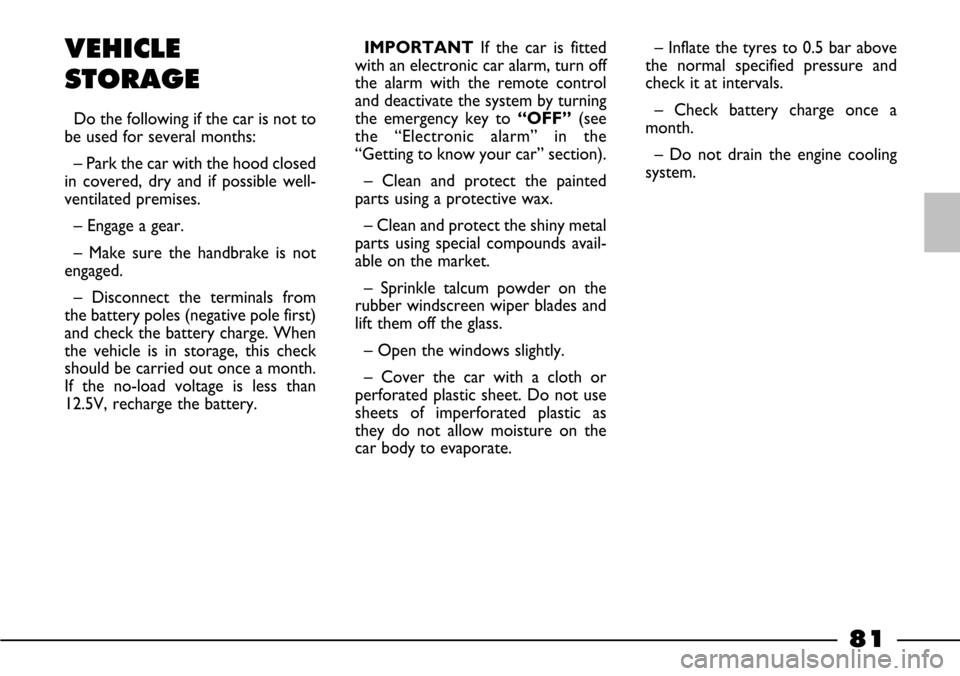
81
VEHICLE
STORAGE
Do the following if the car is not to
be used for several months:
– Park the car with the hood closed
in covered, dry and if possible well-
ventilated premises.
– Engage a gear.
– Make sure the handbrake is not
engaged.
– Disconnect the terminals from
the battery poles (negative pole first)
and check the battery charge. When
the vehicle is in storage, this check
should be carried out once a month.
If the no-load voltage is less than
12.5V, recharge the battery.– Inflate the tyres to 0.5 bar above
the normal specified pressure and
check it at intervals.
– Check battery charge once a
month.
– Do not drain the engine cooling
system. IMPORTANTIf the car is fitted
with an electronic car alarm, turn off
the alarm with the remote control
and deactivate the system by turning
the emergency key to “OFF”(see
the “Electronic alarm” in the
“Getting to know your car” section).
– Clean and protect the painted
parts using a protective wax.
– Clean and protect the shiny metal
parts using special compounds avail-
able on the market.
– Sprinkle talcum powder on the
rubber windscreen wiper blades and
lift them off the glass.
– Open the windows slightly.
– Cover the car with a cloth or
perforated plastic sheet. Do not use
sheets of imperforated plastic as
they do not allow moisture on the
car body to evaporate.
Page 83 of 170
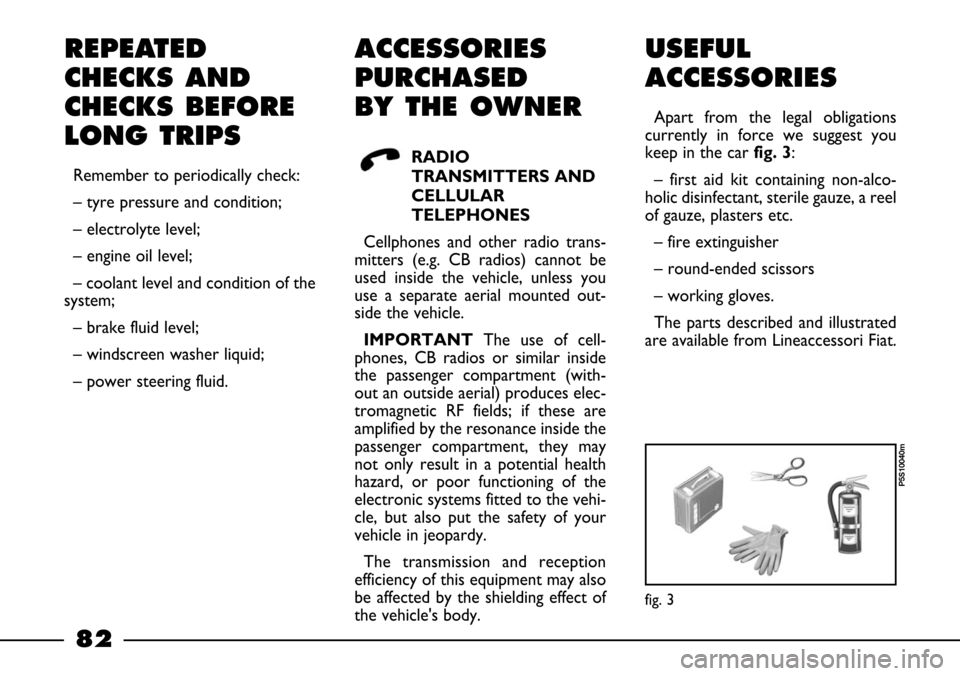
82
REPEATED
CHECKS AND
CHECKS BEFORE
LONG TRIPS
Remember to periodically check:
– tyre pressure and condition;
– electrolyte level;
– engine oil level;
– coolant level and condition of the
system;
– brake fluid level;
– windscreen washer liquid;
– power steering fluid.
ACCESSORIES
PURCHASED
BY THE OWNER
RADIO
TRANSMITTERS AND
CELLULAR
TELEPHONES
Cellphones and other radio trans-
mitters (e.g. CB radios) cannot be
used inside the vehicle, unless you
use a separate aerial mounted out-
side the vehicle.
IMPORTANTThe use of cell-
phones, CB radios or similar inside
the passenger compartment (with-
out an outside aerial) produces elec-
tromagnetic RF fields; if these are
amplified by the resonance inside the
passenger compartment, they may
not only result in a potential health
hazard, or poor functioning of the
electronic systems fitted to the vehi-
cle, but also put the safety of your
vehicle in jeopardy.
The transmission and reception
efficiency of this equipment may also
be affected by the shielding effect of
the vehicle's body.
USEFUL
ACCESSORIES
Apart from the legal obligations
currently in force we suggest you
keep in the car fig. 3:
– first aid kit containing non-alco-
holic disinfectant, sterile gauze, a reel
of gauze, plasters etc.
– fire extinguisher
– round-ended scissors
– working gloves.
The parts described and illustrated
are available from Lineaccessori Fiat.
fig. 3
P5S10040m
Page 88 of 170
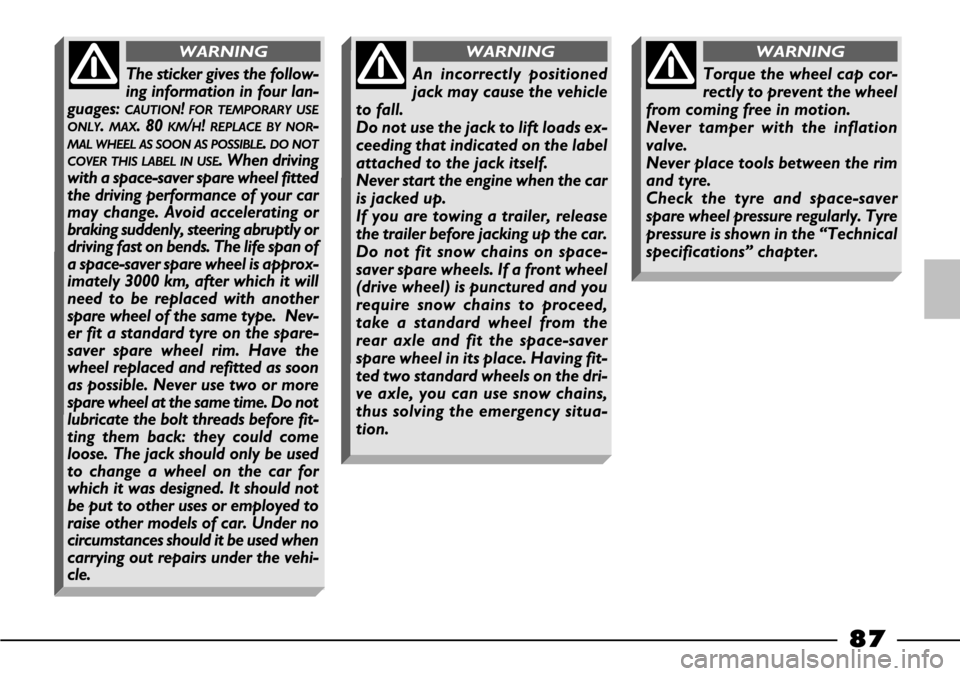
The sticker gives the follow-
ing information in four lan-
guages:
CAUTION!FOR TEMPORARY USE
ONLY
. MAX. 80 KM/H! REPLACE BY NOR-
MAL WHEEL AS SOON AS POSSIBLE. DO NOT
COVER THIS LABEL IN USE
. When driving
with a space-saver spare wheel fitted
the driving performance of your car
may change. Avoid accelerating or
braking suddenly, steering abruptly or
driving fast on bends. The life span of
a space-saver spare wheel is approx-
imately 3000 km, after which it will
need to be replaced with another
spare wheel of the same type. Nev-
er fit a standard tyre on the spare-
saver spare wheel rim. Have the
wheel replaced and refitted as soon
as possible. Never use two or more
spare wheel at the same time. Do not
lubricate the bolt threads before fit-
ting them back: they could come
loose. The jack should only be used
to change a wheel on the car for
which it was designed. It should not
be put to other uses or employed to
raise other models of car. Under no
circumstances should it be used when
carrying out repairs under the vehi-
cle.
87
WARNING
An incorrectly positioned
jack may cause the vehicle
to fall.
Do not use the jack to lift loads ex-
ceeding that indicated on the label
attached to the jack itself.
Never start the engine when the car
is jacked up.
If you are towing a trailer, release
the trailer before jacking up the car.
Do not fit snow chains on space-
saver spare wheels. If a front wheel
(drive wheel) is punctured and you
require snow chains to proceed,
take a standard wheel from the
rear axle and fit the space-saver
spare wheel in its place. Having fit-
ted two standard wheels on the dri-
ve axle, you can use snow chains,
thus solving the emergency situa-
tion.
WARNING
Torque the wheel cap cor-
rectly to prevent the wheel
from coming free in motion.
Never tamper with the inflation
valve.
Never place tools between the rim
and tyre.
Check the tyre and space-saver
spare wheel pressure regularly. Tyre
pressure is shown in the “Technical
specifications” chapter.
WARNING
Page 112 of 170
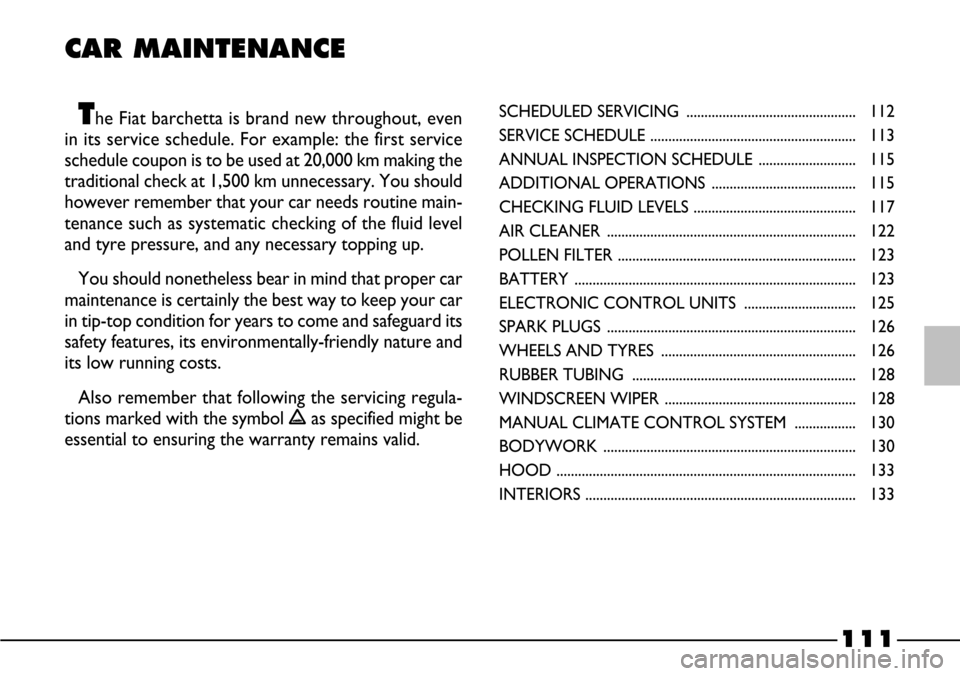
111
CAR MAINTENANCE
The Fiat barchetta is brand new throughout, even
in its service schedule. For example: the first service
schedule coupon is to be used at 20,000 km making the
traditional check at 1,500 km unnecessary. You should
however remember that your car needs routine main-
tenance such as systematic checking of the fluid level
and tyre pressure, and any necessary topping up.
You should nonetheless bear in mind that proper car
maintenance is certainly the best way to keep your car
in tip-top condition for years to come and safeguard its
safety features, its environmentally-friendly nature and
its low running costs.
Also remember that following the servicing regula-
tions marked with the symbol ∑as specified might be
essential to ensuring the warranty remains valid.SCHEDULED SERVICING ............................................... 112
SERVICE SCHEDULE ......................................................... 113
ANNUAL INSPECTION SCHEDULE ........................... 115
ADDITIONAL OPERATIONS ........................................ 115
CHECKING FLUID LEVELS ............................................. 117
AIR CLEANER ..................................................................... 122
POLLEN FILTER .................................................................. 123
BATTERY .............................................................................. 123
ELECTRONIC CONTROL UNITS ............................... 125
SPARK PLUGS ..................................................................... 126
WHEELS AND TYRES ...................................................... 126
RUBBER TUBING .............................................................. 128
WINDSCREEN WIPER ..................................................... 128
MANUAL CLIMATE CONTROL SYSTEM ................. 130
BODYWORK ...................................................................... 130
HOOD ................................................................................... 133
INTERIORS ........................................................................... 133
Page 114 of 170
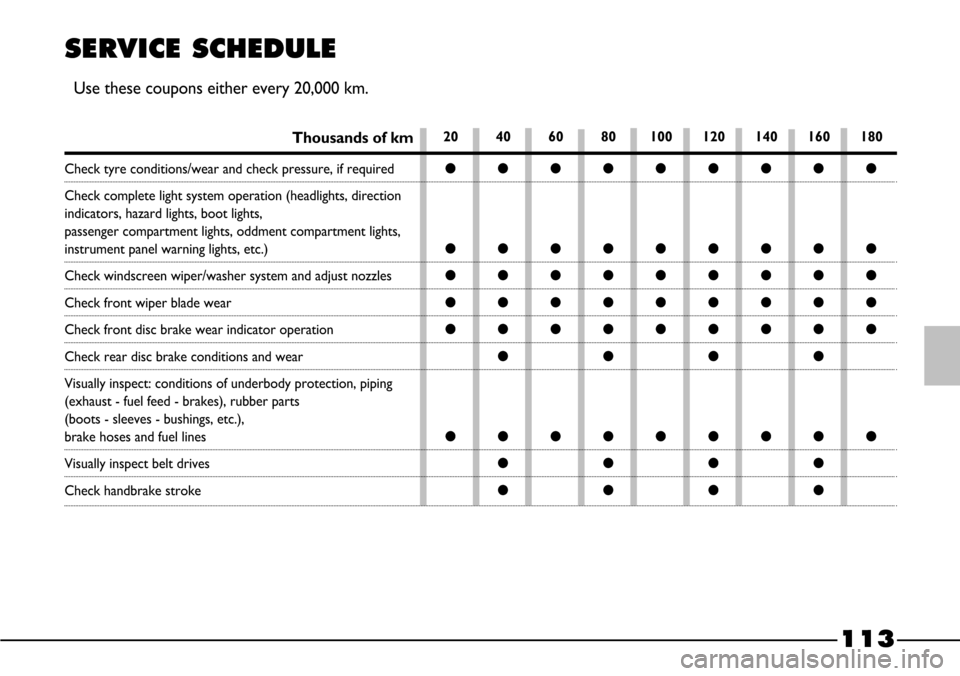
113
SERVICE SCHEDULE
Use these coupons either every 20,000 km.
Thousands of km20 40 60 80 100 120 140 160 180
Check tyre conditions/wear and check pressure, if required
Check complete light system operation (headlights, direction
indicators, hazard lights, boot lights,
passenger compartment lights, oddment compartment lights,
instrument panel warning lights, etc.)
Check windscreen wiper/washer system and adjust nozzles
Check front wiper blade wear
Check front disc brake wear indicator operation
Check rear disc brake conditions and wear
Visually inspect: conditions of underbody protection, piping
(exhaust - fuel feed - brakes), rubber parts
(boots - sleeves - bushings, etc.),
brake hoses and fuel lines
Visually inspect belt drives
Check handbrake stroke
ççççççççç
ççççççççç
ççççççççç
ççççççççç
ççççççççç
çççç
ççççççççç
çççç
çççç
Page 116 of 170
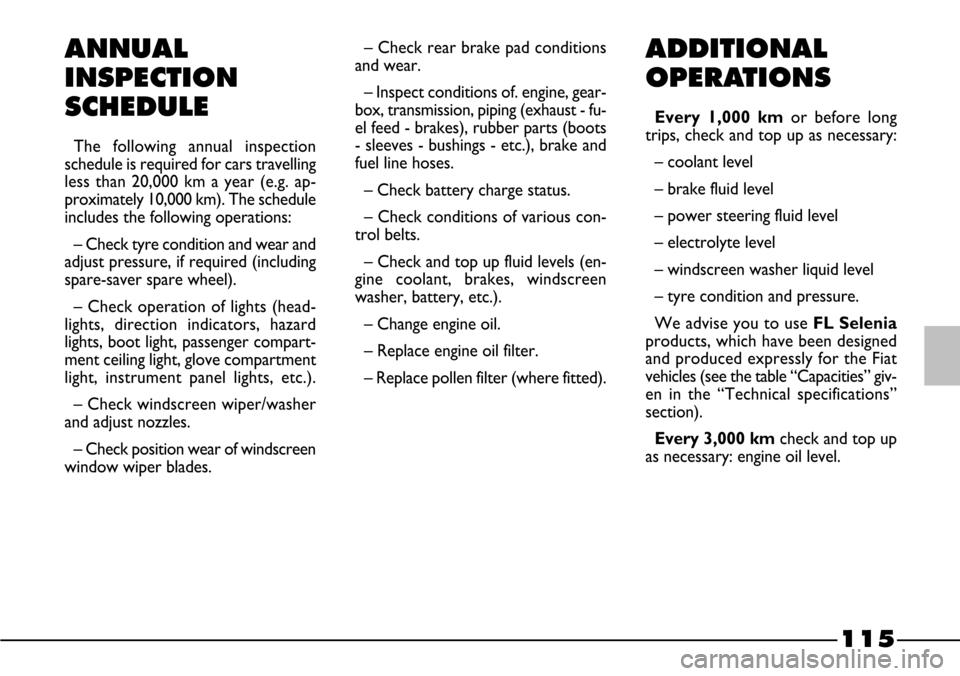
115
ANNUAL
INSPECTION
SCHEDULE
The following annual inspection
schedule is required for cars travelling
less than 20,000 km a year (e.g. ap-
proximately 10,000 km). The schedule
includes the following operations:
– Check tyre condition and wear and
adjust pressure, if required (including
spare-saver spare wheel).
– Check operation of lights (head-
lights, direction indicators, hazard
lights, boot light, passenger compart-
ment ceiling light, glove compartment
light, instrument panel lights, etc.).
– Check windscreen wiper/washer
and adjust nozzles.
– Check position wear of windscreen
window wiper blades.
ADDITIONAL
OPERATIONS
Every 1,000 kmor before long
trips, check and top up as necessary:
– coolant level
– brake fluid level
– power steering fluid level
– electrolyte level
– windscreen washer liquid level
– tyre condition and pressure.
We advise you to use FL Selenia
products, which have been designed
and produced expressly for the Fiat
vehicles (see the table “Capacities” giv-
en in the “Technical specifications”
section).
Every 3,000 km check and top up
as necessary: engine oil level. – Check rear brake pad conditions
and wear.
– Inspect conditions of. engine, gear-
box, transmission, piping (exhaust - fu-
el feed - brakes), rubber parts (boots
- sleeves - bushings - etc.), brake and
fuel line hoses.
– Check battery charge status.
– Check conditions of various con-
trol belts.
– Check and top up fluid levels (en-
gine coolant, brakes, windscreen
washer, battery, etc.).
– Change engine oil.
– Replace engine oil filter.
– Replace pollen filter (where fitted).
Page 127 of 170
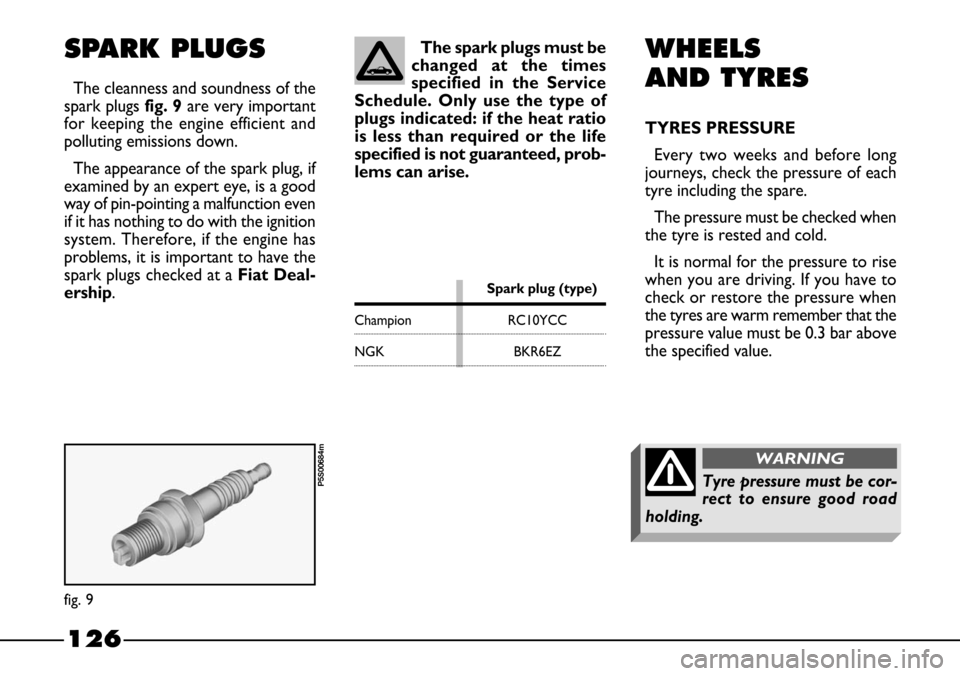
126
WHEELS
AND TYRES
TYRES PRESSURE
Every two weeks and before long
journeys, check the pressure of each
tyre including the spare.
The pressure must be checked when
the tyre is rested and cold.
It is normal for the pressure to rise
when you are driving. If you have to
check or restore the pressure when
the tyres are warm remember that the
pressure value must be 0.3 bar above
the specified value.
SPARK PLUGS
The cleanness and soundness of the
spark plugs fig. 9are very important
for keeping the engine efficient and
polluting emissions down.
The appearance of the spark plug, if
examined by an expert eye, is a good
way of pin-pointing a malfunction even
if it has nothing to do with the ignition
system. Therefore, if the engine has
problems, it is important to have the
spark plugs checked at a Fiat Deal-
ership.The spark plugs must be
changed at the times
specified in the Service
Schedule. Only use the type of
plugs indicated: if the heat ratio
is less than required or the life
specified is not guaranteed, prob-
lems can arise.
fig. 9
P5S00684m
Spark plug (type)
Champion RC10YCC
NGK BKR6EZ
Tyre pressure must be cor-
rect to ensure good road
holding.
WARNING
Page 128 of 170

127
Wrong pressure causes uneven wear
of the tyresfig. 10:
A- Correct pressure: tyre wears
evenly.
B- Underinflated tyre: shoulder
tread wear.
C- Overinflated tyre: centre tread
wear.If you get a flat tyre, stop immediately
and change it so as not to damage the
tyre, the wheel, the suspension and
the steering.
Tyres age even if they are not used
very much. Cracking of the tread rub-
ber and the side-walls are a sign of this
ageing. In any case, if the tyres have
been fitted for more than six years
they should be examined by an expert
who can judge whether they are still
fit for use. Remember to check the
spare tyre particularly carefully too.
If a replacement is necessary, always
use new tyres and avoid using ones the
origin of which you are not certain
about.
The Fiat barchetta uses Tubeless
tyres. Under no circumstances use an
inner tube with these tyres.
If you replace a tyre it is a good idea
to change the inflation valve, too. Tyres must be replaced when the
tread wears down to 1.6 mm. Comply
with the laws in the country where the
car is being driven.
IMPORTANT
As far as possible avoid sharp brak-
ing and screech starts.
Be careful not to hit the pavement,
potholes or other obstacles hard. Dri-
ving for long stretches over bumpy
roads can damage the tyres.
Periodically check that the tyres have
no cuts in the side wall, abnormal
swelling or irregular tyre wear. If any
of these occur, have the car seen to at
a Fiat Dealership.
Avoid travelling with an overloaded
car: this can seriously damage wheels
or tyres.
fig. 10
P5S00685m
If the pressure is too low
the tyre overheats and this
can cause it serious damage.
WARNING